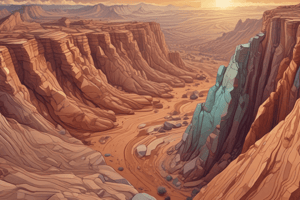Podcast
Questions and Answers
This process causes rock to break down into smaller pieces called sediment: ________________.
This process causes rock to break down into smaller pieces called sediment: ________________.
Weathering
Name the 3 types of rock.
Name the 3 types of rock.
Sedimentary, Igneous, and Metamorphic
This action is the movement of sediments to rivers and lakes: ______________.
This action is the movement of sediments to rivers and lakes: ______________.
Erosion
This is the accumulation of sediment in lakes, oceans, or on floodplains: __________.
This is the accumulation of sediment in lakes, oceans, or on floodplains: __________.
Sedimentary rock is formed by _______________ and ______________.
Sedimentary rock is formed by _______________ and ______________.
Two types of igneous rock are ____________ and ____________.
Two types of igneous rock are ____________ and ____________.
What causes sedimentary and igneous rock to become metamorphic rock? ____________ and ____________.
What causes sedimentary and igneous rock to become metamorphic rock? ____________ and ____________.
Intrusive igneous rock forms __________________________________________________.
Intrusive igneous rock forms __________________________________________________.
Extrusive igneous rock forms __________________________________________________.
Extrusive igneous rock forms __________________________________________________.
Can any rock become a sedimentary rock?
Can any rock become a sedimentary rock?
How can any rock become a sedimentary rock?
How can any rock become a sedimentary rock?
Flashcards are hidden until you start studying
Study Notes
Rock Basics
- Rock is a natural solid composed of one or more minerals and organic matter.
- Rock Cycle describes the continuous transformation of rock types: sedimentary, igneous, and metamorphic.
Sedimentary Rock
- Formed through weathering and erosion, deposition, compaction, and cementation.
- Sediment consists of broken rock and mineral fragments resulting from weathering.
- Any type of rock can eventually become sedimentary if exposed at the Earth's surface.
- Fossils are typically found within sedimentary rocks.
Weathering and Erosion
- Weathering refers to the breakdown of rock caused by natural forces like water and temperature changes.
- Erosion is the movement of sediment by wind and water.
Deposition, Compaction, and Cementation
- Deposition is the accumulation of sediment in layered formations.
- Compaction squeezes sediment layers together due to the weight of overlying materials.
- Cementation binds sediment into solid rock.
Examples of Sedimentary Rocks
- Breccia: Contains angular fragments.
- Shale: Composed of fine particles, often layers.
- Sandstone: Made of sand-sized particles.
Igneous Rock
- Igneous rocks form from the cooling and solidification of hot molten rock (magma).
- Extrusive igneous rock forms near or at the Earth's surface during volcanic eruptions and cools quickly; examples include pumice and obsidian.
- Intrusive igneous rock forms from magma that cools slowly beneath the Earth's surface, resulting in rocks like granite.
Black Sand Beach
- Punalu'u beach in Hawaii features black sand created from lava that cooled rapidly in the ocean, breaking into sand-sized particles.
Metamorphic Rock
- Formed from sedimentary or igneous rocks that undergo change due to heat and pressure.
- Examples include slate (from shale) and marble (from limestone).
Key Processes and Concepts
- The rock cycle illustrates how rocks transform from one type to another through natural processes.
- Intrusive igneous rocks often rise to the surface due to plate tectonics and uplift forces.
- Heat and pressure are primary agents that transform sedimentary and igneous rocks into metamorphic rocks.
- Any rock type can ultimately become sedimentary through weathering and accumulation processes.
Studying That Suits You
Use AI to generate personalized quizzes and flashcards to suit your learning preferences.




